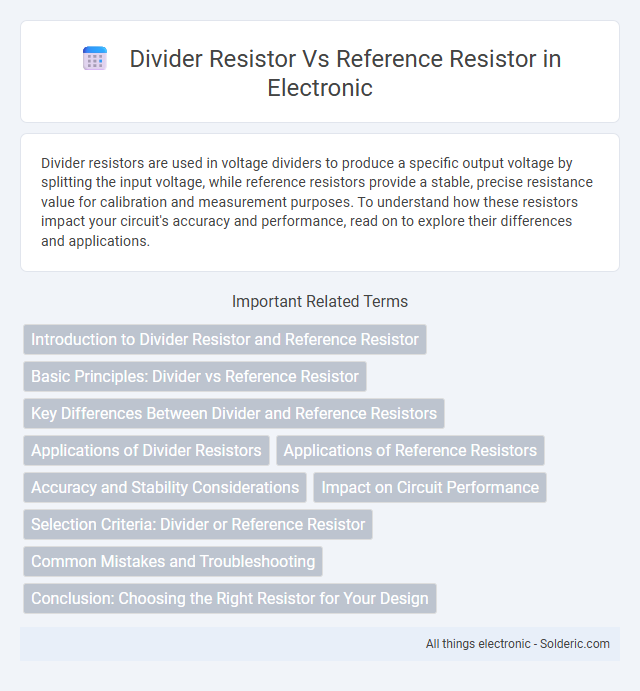Divider resistors are used in voltage dividers to produce a specific output voltage by splitting the input voltage, while reference resistors provide a stable, precise resistance value for calibration and measurement purposes. To understand how these resistors impact your circuit's accuracy and performance, read on to explore their differences and applications.
Comparison Table
| Feature | Divider Resistor | Reference Resistor |
|---|---|---|
| Primary Function | Voltage division | Accurate current or voltage reference |
| Accuracy | Moderate, depends on resistor tolerances | High, precision resistor with low tolerance |
| Purpose | Reduce voltage to required levels | Establish stable reference values in circuits |
| Resistance Stability | Less critical | Crucial, with minimal drift |
| Applications | Signal conditioning, sensor interfacing | Voltage regulators, ADC references |
| Cost | Low | Higher due to precision nature |
| Tolerance | 1% to 5% | 0.1% or better |
Introduction to Divider Resistor and Reference Resistor
Divider resistors are components used in voltage divider circuits to proportionally reduce voltage levels for measurement or signal conditioning, typically consisting of two resistors connected in series. Reference resistors provide a stable and precise resistance value essential for accurate calibration and comparison in measurement devices, ensuring consistent performance over varying conditions. Both play crucial roles in electronic circuits, where divider resistors adjust voltage output and reference resistors maintain accuracy in resistance-based sensing applications.
Basic Principles: Divider vs Reference Resistor
A divider resistor is used in voltage divider circuits to scale down voltage levels proportionally based on the ratio of resistors, enabling measurement or interfacing with lower voltage components. A reference resistor provides a stable and precise resistance value to serve as a benchmark for current or voltage measurements, ensuring accuracy and consistency in electronic circuits. Your choice between the two depends on whether you need voltage scaling or a stable reference point for measurement.
Key Differences Between Divider and Reference Resistors
Divider resistors are used to create a specific voltage output by dividing the input voltage proportionally based on the resistor ratio, typically found in voltage divider circuits. Reference resistors provide a stable, precise resistance value essential for calibration and measurement accuracy in devices like current sensors and temperature controllers. The key difference lies in their application: divider resistors tailor voltage levels, while reference resistors ensure measurement consistency and accuracy through their fixed, known resistance.
Applications of Divider Resistors
Divider resistors are commonly utilized in voltage divider circuits to scale down high voltages to measurable levels for sensors and microcontrollers. They enable precise voltage sensing in applications such as battery monitoring, signal conditioning, and analog-to-digital converter (ADC) input adjustments. Unlike reference resistors, which provide stable resistance standards for calibration, divider resistors primarily facilitate voltage measurement and signal scaling in electronic circuits.
Applications of Reference Resistors
Reference resistors serve as precision components in calibration systems, providing stable resistance values crucial for accurate measurement and instrumentation. They are extensively used in bridge circuits, sensor calibration, and quality control laboratories to ensure consistent performance and repeatability. Their high stability and low temperature coefficient make them indispensable in high-accuracy applications like metrology and sensor signal conditioning.
Accuracy and Stability Considerations
Divider resistors often exhibit lower accuracy due to tolerance variations and temperature coefficients affecting voltage division ratios, while reference resistors are specifically designed for high precision with tight tolerance and low temperature drift. Stability in reference resistors is achieved through superior materials and construction, ensuring consistent resistance values over time and varying environmental conditions. For applications demanding precise voltage measurements, choosing reference resistors enhances accuracy and stability compared to general-purpose divider resistors.
Impact on Circuit Performance
A divider resistor influences circuit performance by determining voltage division accuracy and affecting overall power dissipation, where high tolerance values can lead to measurement errors and instability. Reference resistors provide a stable and precise resistance value critical for accurate current sensing and reference voltage generation, directly impacting the circuit's precision and reliability. Selecting low-temperature coefficient and high-stability reference resistors minimizes drift, enhancing performance in sensitive analog and measurement applications.
Selection Criteria: Divider or Reference Resistor
Selection criteria for divider resistors prioritize voltage division accuracy and power dissipation, focusing on resistor values that balance load effect and sensitivity in voltage measurement circuits. Reference resistors demand ultra-low tolerance, minimal temperature coefficient, and long-term stability to ensure precise and consistent current or voltage reference in high-accuracy applications. Your choice hinges on the application's tolerance for error, stability requirements, and environmental conditions impacting resistor performance.
Common Mistakes and Troubleshooting
Common mistakes when using divider resistors instead of reference resistors include inaccurate voltage readings due to resistor tolerance and temperature variations, which can lead to system measurement errors. Troubleshooting often involves verifying resistor values with a precise multimeter and ensuring resistor stability under operating conditions, as reference resistors are designed for higher accuracy and reliability. To maintain measurement integrity, your circuit should prioritize reference resistors when precision voltage references are critical, avoiding issues caused by voltage drop and loading effects in divider resistor setups.
Conclusion: Choosing the Right Resistor for Your Design
Selecting the right resistor depends on your specific circuit requirements: divider resistors are ideal for setting voltage levels through ratio-based outputs, while reference resistors provide precise, stable resistance values crucial for accurate measurements. Your design benefits from divider resistors when adjustable output is needed, whereas reference resistors ensure reliability in calibration and sensing applications. Understanding these functional differences will optimize performance and accuracy in your electronic projects.
divider resistor vs reference resistor Infographic

 solderic.com
solderic.com